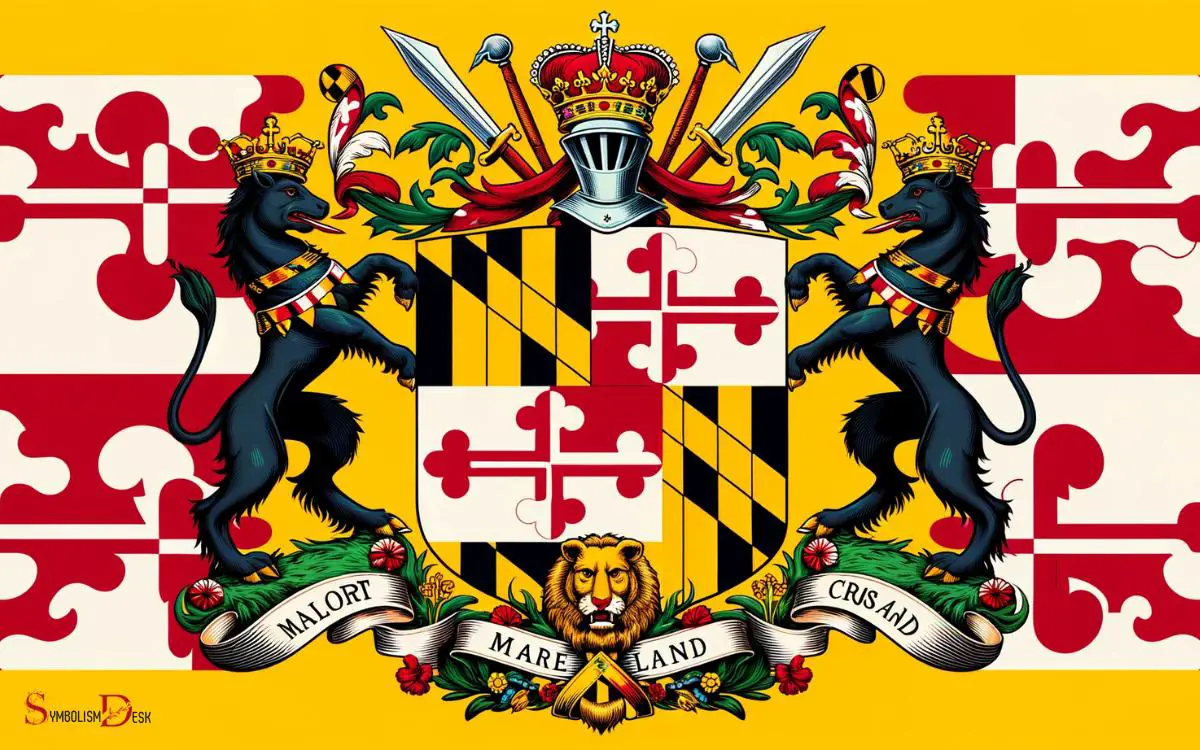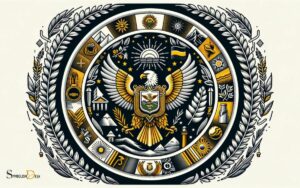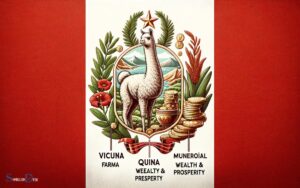What Do the Symbols on the Maryland Flag Mean? Banner!
The symbols on the Maryland flag represent the heraldic banner of George Calvert, the first Lord Baltimore.
The black and gold design on the diagonal quarter of the flag represents the arms of the Calvert line. The red and white design represents the arms of the Crossland line, the family of Calvert’s mother.
The Maryland flag is a combination of the coat of arms of two historic English families – the Calverts and the Crosslands. The flag includes the emblems of both families as a symbol of unity and heritage.
The black and gold checkered pattern is a representation of the coat of arms of George Calvert, the founder of the Maryland colony. The red and white cross is derived from the Crossland family’s coat of arms, the family of George Calvert’s mother.

Key Takeaway
5 Symbols and Meanings of the Maryland Flag
| Symbol | Meaning |
|---|---|
| Black and Gold Checkered Pattern | Represents the family crest of George Calvert, the first Baron of Baltimore. It represents his paternal family. |
| Red and White Cross | Also from the family crest of George Calvert. This time, it represents his maternal family, the Crosslands. |
| Botonee Cross | A type of Christian cross with trefoils at the ends. It symbolizes Maryland’s history as an intended haven for persecuted Catholics from England. |
| White and Red Colors | Represent the Crossland family. Red and white were their heraldic colors. |
| Black and Gold Colors | Represent the Calvert family, as these were their heraldic colors. |
The Origins of the Maryland Flag
The origins of the Maryland flag can be traced back to the 17th century when it was first used as the banner of English colonists. The flag’s design is based on the coat of arms of the Calvert and Crossland families, which were prominent in Maryland’s early history.
The black and gold design represents the Calvert family, while the red and white design represents the Crossland family. The fusion of these two family crests on the flag symbolizes the unity of the state.
The history of the Maryland flag is deeply intertwined with the state’s colonial past and the families that played a significant role in its development.
Understanding the historical context of the flag provides insight into its unique design and symbolism, particularly the significance of the Crossland banner.
The Crossland Banner
The Crossland Banner on the Maryland flag holds deep historical significance, representing the Crossland family’s coat of arms. This symbol is a nod to the colonial roots of Maryland and the influential role of the Crossland family in the state’s history.
Understanding the symbolism and history of the Crossland Banner provides valuable insights into the Maryland flag’s rich heritage.
Crossland Banner Symbolism
Symbolizing the Crossland family, the Crossland Banner on the Maryland flag holds historical significance.
The Crossland family was a prominent one in Maryland’s history, and their banner is represented on the state flag. The Crossland Banner is depicted in the upper left and lower right quadrants of the flag.
Here’s what the symbolism of the Crossland Banner represents:
- Black and Gold Colors: The colors of the Crossland Banner are black and gold, which are associated with the Crossland family’s coat of arms.
- Cross Botonnee Design: The Crossland Banner features a cross botonnee design, which is a variation of the Christian cross, symbolizing the family’s religious faith.
- Historical Legacy: The inclusion of the Crossland Banner on the Maryland flag serves as a reminder of the state’s historical legacy and the influential families that shaped its past.
- Heritage and Pride: For Marylanders, the Crossland Banner represents heritage and pride in the state’s rich history.
Historical Significance of Crossland
The historical significance of the Crossland Banner on the Maryland flag lies in its representation of the influential Crossland family and their enduring impact on the state’s history. The Crossland family played a pivotal role in shaping Maryland’s early colonial development.
The Crossland Banner, with its distinctive red and white design, is a testament to the family’s prominence and influence.
It is believed that the Crossland family’s involvement in the founding and governance of Maryland led to the inclusion of their banner on the state flag.
The banner’s presence serves as a reminder of the state’s rich historical heritage and the contributions of the Crossland family to Maryland’s development.
As such, the Crossland Banner symbolizes a significant aspect of Maryland’s history and the enduring legacy of the Crossland family.
The Calvert Banner
The Calvert Banner has been a prominent feature of the Maryland flag since its adoption in 1904. The banner is based on the coat of arms of the Calvert family, the colonial proprietors of Maryland.
The banner consists of a black and gold design that symbolizes the Calvert family’s heritage and power.
The flag’s design is rooted in history, representing the rich legacy of Maryland and its connection to the Calvert family. The Calvert Banner serves as a reminder of the state’s colonial origins and the influence of the Calvert family in shaping Maryland’s history and identity.
- The Calvert Banner is a key element of the Maryland flag.
- It is based on the coat of arms of the Calvert family.
- The design features black and gold colors.
- It symbolizes the Calvert family’s heritage and influence in Maryland.
Historical Context of the Symbols
The symbols on the Maryland flag have deep historical significance, and understanding their origins provides insight into the state’s rich heritage.
By exploring the symbolic representation of these elements throughout history, we can gain a deeper appreciation for their enduring significance.
Additionally, examining the evolution of the flag’s design offers valuable context for understanding the enduring legacy of its symbols.
Origins of Flag Symbols
Symbolizing the state’s rich history and heritage, the Maryland flag’s symbols have deep historical origins rooted in the state’s colonial past.
The flag’s design dates back to the 17th century and incorporates various elements that represent Maryland’s history and culture.
The origins of the flag’s symbols can be traced to:
- The Crossland Banner: This symbol originates from the Crossland family coat of arms, representing the colonial heritage of Maryland.
- The Calvert Family: The flag also features the yellow and black colors of the Calvert family, who were the colonial proprietors of Maryland.
- The Red and White Cross: This design element is derived from the Crossland coat of arms and is a nod to George Calvert, the first Lord Baltimore, who founded the Maryland colony.
- Heraldic Symbols: The flag incorporates heraldic symbols that are historically significant to Maryland’s colonial past.
These symbols have endured over the years, reflecting Maryland’s enduring history and legacy. The historical context of the flag’s symbols provides insight into the symbolic representation in history.
Symbolic Representation in History
Rooted in the historical context of Maryland’s colonial past, the symbolic representation of the flag’s elements provides a meaningful insight into the state’s rich heritage and legacy.
The flag’s design, featuring the family crest of the Calvert and Crossland families, reflects the history of Maryland’s founding.
The black and gold design on the flag represents the Calvert family, with the colors being those associated with Lord Baltimore, the founder of Maryland.
The red and white cross bottony design represents the Crossland family, and it is derived from the Crossland coat of arms.
This historical symbolism serves as a reminder of Maryland’s colonial roots and the influence of the Calvert and Crossland families in the state’s early history.
Understanding the historical context of these symbols provides a deeper appreciation for Maryland’s enduring legacy.
Evolution of Flag Design
The evolution of the Maryland flag design, historically contextualized through its symbols, showcases the state’s enduring heritage and legacy. The flag’s transformation reflects the state’s rich history and the values it holds dear.
Here’s a glimpse into the evolution of the Maryland flag design:
- Pre-Revolutionary War: Maryland’s first flag, believed to have been in use before the Revolutionary War, featured the family crest of the Calvert and Crossland families, the colonial proprietors of Maryland.
- Civil War Era: During the Civil War, Marylanders who remained loyal to the Union used a version of the state flag with the gold and black portions of the Calvert family’s coat of arms.
- Post-Civil War: After the Civil War, the flag’s design was officially standardized, featuring the familiar patterns and colors still seen today.
- Modern Era: The Maryland flag, as we know it, was officially adopted in 1904, carrying forward the enduring legacy of the state’s symbols.
Symbolism of the Colors
The colors on the Maryland state flag hold significant symbolism representing the state’s history and heritage.
The flag’s bold design features the heraldic colors of red and white, which are derived from the coat of arms of the Calvert and Crossland families, who were the colonial proprietors of Maryland.
The black and gold designs, also known as the chevron, are taken from the Calvert family’s coat of arms. The red and white design is from the Crossland family’s coat of arms.
The black and gold sections collectively represent the heritage of Lord Baltimore, who founded Maryland as a haven for English Catholics in the 17th century.
This unique combination of colors and designs on the flag reflects Maryland’s rich and diverse historical roots.
Evolution of the Flag Design
One significant aspect to consider in the study of the Maryland state flag is the evolution of its design. Understanding the changes in the flag’s design provides insight into the historical and cultural influences that have shaped its current form.
The evolution of the Maryland flag design can be summarized as follows:
- Original Design: The first official Maryland flag was adopted in 1904, featuring the family crest of the Calvert and Crossland families.
- Confederate Influence: In the 20th century, the flag incorporated Confederate symbols, reflecting historical ties to the Confederacy.
- Modern Redesign: In 1888, a new flag was designed, integrating the original elements but omitting Confederate symbols to promote unity.
- Current Flag: The modern Maryland flag, adopted in 1904, proudly displays the colorful and distinctive design that represents the state’s complex history and diverse heritage.
Cultural Significance
Cultural heritage in Maryland is reflected through the symbols on its flag, embodying a rich history and diverse influences.
The flag’s design pays homage to the state’s English heritage, as evidenced by the prominent use of the Crossland family and Calvert family coats of arms.
The red and white design, featuring the cross bottony and the black and gold design with the Calvert family colors, reflects the early colonial history of Maryland.
This cultural significance is further emphasized by the flag’s unique status as the only US state flag to be based on English heraldry.
The flag serves as a powerful symbol of Maryland’s cultural identity, acknowledging the state’s historical ties to England while also representing the diverse and inclusive character of its modern society.
What Do the Symbols on the Florida State Flag Mean compared to the Maryland Flag?
The symbols on the florida state flag prominently feature a red saltire cross representing the state’s Christian heritage, as well as the main seal in the center portraying a Seminole woman planting crops. On the other hand, the Maryland flag contains a unique design with bold patterns of black and gold. The symbol of the Maryland flag represents the combination of the coats of arms of two prominent families within Maryland’s history, the Calvert and Crossland families.
What Do the Symbols on the Maryland Flag Mean Compared to the Symbols on the Wisconsin Flag?
The symbols on Wisconsin’s flag represent the state’s rich history and culture. The flag features the state coat of arms, which includes a sailor and a miner representing Wisconsin’s maritime and mining industries. In contrast, the symbols on the Maryland flag are the Calvert and Crossland arms, representing the founding families who played significant roles in the state’s history. While both flags showcase important elements, their symbols differ in meaning and significance.
Contemporary Use and Recognition
The Maryland flag’s contemporary use and recognition extend beyond its historical significance, serving as a unifying symbol for the state’s diverse populace. Its presence can be seen across various facets of Maryland life,
including:
- Official Use: The flag is prominently displayed at government buildings, schools, and public events, representing the state’s unity and heritage.
- Commercial Branding: Many Maryland-based companies incorporate the flag’s distinctive design into their logos and branding to showcase their local roots and connect with the state’s identity.
- Sports Teams: The flag is proudly worn and displayed by Maryland sports teams and their fans, fostering a sense of pride and belonging among supporters.
- Cultural Events: During festivals and celebrations, the flag is a ubiquitous symbol, reflecting the state’s inclusive and vibrant cultural tapestry.
Conclusion
In summary, the symbols on the Maryland flag have deep historical and cultural significance.
The Crossland and Calvert banners represent the state’s colonial history and the founding families of Maryland.
The colors of red, white, and black hold symbolic meaning, and the flag’s design has evolved over time.
Today, the flag is widely recognized and holds important cultural significance for the state of Maryland.
behind the symbols on the maryland flag, as they represent a remarkable history and living traditions.






